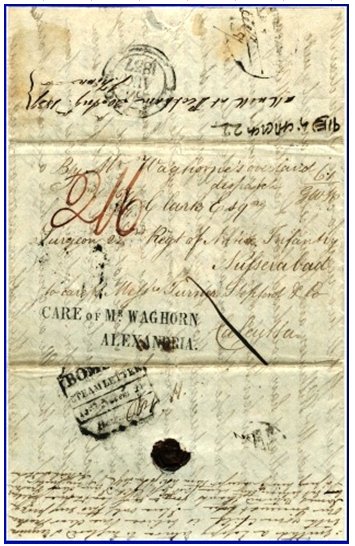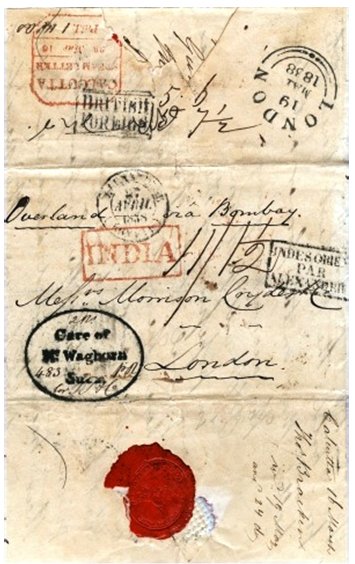PRESENT: Eleven members were present; apologies for absence were received from seven members.
Those members perspicacious enough to gather on a blazing hot London afternoon in the air-conditioned calm of the Royal Philatelic Society headquarters were treated to an outstanding display and talk on The Overland Route by one of the Royal's Fellows, Dr Geoffrey Eibl-Kaye of Winchester.
 As far as the Circle is concerned, the Overland Route has to do with passage of the mails through Egypt itself. But as Dr Eibl-Kaye indicated, all of the 200 or so covers on display - each of them intimately written up in great detail - had passed through Egypt en route between India and the UK but very few bore any such indication. Only those covers handled by forwarding agents based in Egypt - of whom of course Thomas Waghorn was far and away the best known and most active - were likely to show any "Egyptian" markings of any sort. For security purposes, the mails were locked securely away in metal or wooden boxes or sealed in canvas bags, untouched during their passage through Egypt.
As far as the Circle is concerned, the Overland Route has to do with passage of the mails through Egypt itself. But as Dr Eibl-Kaye indicated, all of the 200 or so covers on display - each of them intimately written up in great detail - had passed through Egypt en route between India and the UK but very few bore any such indication. Only those covers handled by forwarding agents based in Egypt - of whom of course Thomas Waghorn was far and away the best known and most active - were likely to show any "Egyptian" markings of any sort. For security purposes, the mails were locked securely away in metal or wooden boxes or sealed in canvas bags, untouched during their passage through Egypt.
As a forwarding agent between Alexandria and Suez, Waghorn's method of working was to accept a piece of postal material, place upon it one of his characteristic handstamps - and pop it into the normal mails for onward transmission. For this service he charged a fee - and it is easy to see why mails handled in this way have become sought-after over the years.
Dr Eibl-Kaye showed two Waghorn covers, one of them handled in Egypt for 2s 3d en route between Falmouth and Bombay (80 days transit between August and November 1837) with the Care of Mr Waghorn / Alexandria two-line handstamp; the other taking 64 days to pass between Calcutta and London via Marseilles between March and May 1838 at a total charge of 19s. This one received the Care of / Mr Waghorn / Suez oval handstamp. Between them they helped to paint a picture of just where Waghorn fitted in to the much wider global panorama of mails between India and the UK.
But the range of research displayed by Dr Eibl-Kaye went well beyond Waghorn and the forwarding agents, important though they may have been, and delved deep into the long significance of the East India Company in acting in effect for the British Government in all trade, including handling the mails from India, from about 1600 right up until 1854. Relations were not always harmonious.
The sea route around Cape of Good Hope at the tip of southern Africa was long and arduous, wasteful and frustrating. One letter displayed took no fewer than 476 days to travel from Tellicherry via Bombay and St Helena to Bath between April 1782 and September 1783. This was, admittedly, an exception: more usual was between 130 and 170 days' transit.
 Clearly an overland route would save time and expense, reducing the journey from 16,000 miles to 6,000 miles. Waghorn offered many suggestions, but was ignored by the East India Company and the Post Office, concentrating instead on moving passengers from Alexandria to Suez via Cairo.
Clearly an overland route would save time and expense, reducing the journey from 16,000 miles to 6,000 miles. Waghorn offered many suggestions, but was ignored by the East India Company and the Post Office, concentrating instead on moving passengers from Alexandria to Suez via Cairo.
Eventually, after an overland route experiment had been carried out up the Euphrates, Waghorn's ideas bore fruit and what we know today as the Overland Route was established in the late 1830s as follows: inland to one of Bombay, Calcutta or Madras; India to Suez; Suez to Alexandria; and Alexandria to UK via Falmouth (to 1843; then Southampton to 1880), Marseilles (from August 1839) or Brindisi (from October 1870).
Transit time was quickly reduced from 130-170 days to 35 days, and less in exceptional circumstances, and postal rates were reduced as a consequence. Perhaps remarkably, Waghorn's Egypt transit, via coach (Suez-Cairo) and Nile barge (to/from Alexandria) proved its worth even after 1869 when the Suez Canal was opened: slow speeds and night-time restrictions meant that the canal passage was extremely slow.
The breadth and depth of Dr Eibl-Kaye's research goes far beyond what can be recorded in this brief summary. Suffice it to say that with access to the archives of the Post Office and the India Office (which holds the records of the East India Company) he was able to flesh out the bare details of travelled material with many intimate details.
All life aboard ship had to be logged by the master, and all the logs remain available for research - an invaluable primary tool detailing fascinating aspects of life aboard, even to mutinies, and a mail ship being captured by a French man'o'war which was in turn captured by a British vessel whose master wanted to retain the prize for himself... the detail is fascinating, and almost overwhelming. That he was able to complement the research into dates and rates with wonderful anecdotes from the logs, and to illustrate salient points with a breathtaking display of postal material, provided the icing on the cake.
Our President, John Sears, led the appreciation by thanking Dr Eibl-Kay for a "most erudite and interesting display", mentioning that the Circle had been honoured to have on show material that "we would never expect to see in such mass". Members were generous with their applause.
Earlier our Deputy Chairman had welcomed members to our first meeting at the Royal since our 70th Anniversary display in 2005. The Secretary presented a new member for consideration - welcome, Claude Paulson, of Lower Hutt, New Zealand! - and said that he would very much welcome illustrated lists of material for the autumn auction (No 52) on or preferably before August 15.
* The Secretary is grateful to members for pointing out an error in the May meeting report: it was of course Abbas Hilmi II (ruled 1882-1914) who was visiting Constantinople as Khedive at the outbreak of the First World War and not Sultan Hussein Kamel (1914-17).
|

